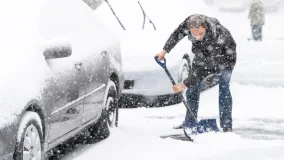Winter Maintenance Checklist for Your Home
It is important to have a winter maintenance checklist for your home because, during the winter months, your home is more likely to experience problems if it is not properly maintained. By following a checklist, you can make sure that all of the necessary tasks are completed so that your home will be in good condition when winter ends. Follow this checklist and you may not have to worry about your home being cold this winter!
Pre-Winter Preparation
Inspect roof and gutters
Clearing out any leaves and debris from the gutters, downspouts and drains will help you avoid clogs and damage from water or ice. Make sure all are securely fastened and in good condition so they do not detach from the house after any significant weather.
Replace weather stripping
Inspect weather stripping around all doors and windows. If you notice any deterioration, replace it immediately. Adding weather stripping or other kinds of insulation to window areas will help prevent heat loss and keep your home and family warm.
Caulk windows and doors
By filling the gaps around your windows and doors with caulking, you can reduce how much cool air enters your home and help to keep yourself warm during winter. This method of weatherproofing can also save you money on heating bills.
Check furnace filters/vents
Keep your furnace filters clean this winter by replacing them regularly and making sure the vents are clear of any obstructions. By taking these measures, your heating system will use less energy, resulting in cost savings on your utility bill.
Inspect your fireplace and chimney
Have your fireplace and chimney inspected by a professional or check it yourself to make sure they are in good condition and safe to use. This is especially important if you plan to use your fireplace during the winter. If so, be sure to keep an eye on it and have it inspected frequently.
Insulate exposed pipes
Insulating exposed pipes will prevent them from freezing and bursting when temperatures drop below freezing. You also want to make sure all valves are turned off and in good condition and that there is no corrosion or water leakage.
Check landscaping for drainage issues
Check around your home for any potential drainage issues. Whether you need to worry about downpours or snow melting, you want to make sure that your landscaping is properly draining away from your home in order to avoid any flooding or foundation issues.
Test smoke and carbon monoxide detectors
Make sure all smoke and carbon monoxide detectors are working properly. This is a vital safety measure to take and should be done on a regular basis, not just in the winter months. However, with heaters and fire being used for warmth, you want to be sure these are in good shape. Change batteries if necessary, and make sure they are placed in the appropriate locations throughout the home.
Protect outdoor furniture, grills and decorations
Protect your outdoor belongings from the harsh winter weather by bringing them indoors or covering them with waterproof covers. This will help ensure they stay in good condition throughout the cold temperatures and weather.
Add additional insulation to help keep your home warm
Adding insulation to your home can help reduce heat loss and keep your house warm during colder months. By layering material like blankets or spray foam in between the exterior and interior of your walls, attic, and flooring, you create a barrier that better retains heat. This results in less wasted energy and can lead to lower monthly heating costs.
During Winter Maintenance
Monitor the roof for signs of damage, such as missing shingles or ice dams
Continuously check for any signs of damage to your roof, such as missing shingles or ice dams throughout the winter. In the event of heavy snowfall or storms, take extra precautions and inspect your roof for any signs of damage.
Inspect windows and doors for drafts/leaks
You want to keep your home as warm and comfortable as possible during the winter. Keep an eye on all windows and doors for any drafts or leaks to make sure you’re keeping cold air out. Have caulk handy during these months for any touch-ups or gaps needing to be filled.
Change furnace filters regularly
Changing your furnace filter regularly will help keep your heating system running efficiently and reduce the amount of energy used. Make sure to check the filters at least once a month and, depending on the material, replace them every few months.
Keep an eye on landscaping and ensure proper drainage to prevent flooding
Continually monitor your drainage systems and landscape as you get rain and snow to ensure everything is working properly. Blocked drains or drains flowing in the wrong direction can cause flooding or pooling that can be even worse in freezing temperatures.
Keep emergency supplies on hand in case of power outages or extreme weather events
Winter weather can cause power outages and extreme temperatures, so it’s important to be prepared. Keep an emergency kit with supplies on hand in case of an emergency. Your kit should include: flashlights, batteries, blankets, water and nonperishable food. A generator is a very useful tool to have in case of a power outage as well, if heat and power are a concern.
Salt walkways/driveway
You can salt your walkways and driveway during winter months to help prevent slippery, icy conditions. Make sure you use the proper type of salt and follow instructions when doing this. Salting can be useful in areas that experience ice or after you finish clearing snow from your walkways and driveway.
Look for signs of rodent infestation
Rats, mice and other rodents may seek shelter in your home during the winter months. Look for any signs of a rodent infestation, such as droppings or chewed wires (which can also be a fire hazard). If you find any signs of rodents in your home, take immediate action and set out traps or call an exterminator.
Acceptance Insurance Can Help Protect You
Winter maintenance is an important part of keeping your home safe and warm during the cold months. It’s important to take the necessary steps to ensure your home and belongings are well taken care of, from checking your furnace filters to preparing for winter storms. But, preparing can only get you so far.
If something does happen to your home, it is imperative to protect it, and yourself, beforehand with some type of homeowners insurance. Learn more about how insurance and Acceptance can help protect you and your home during the winter months.
Common Questions About Winter Home Maintenance
What Type of Salt Should I Use for My Walkways and Driveways?
Different types of salt are more effective in different temperature ranges. For wintertime, rock salt is usually the best option because it’s effective at temperatures below 20 degrees Fahrenheit. However, you should always check with your local hardware store to determine which type of salt would be best for your specific needs.
What Should I Do To Prepare My Home for Extreme Weather Events?
It’s important to make sure your home is prepared for any extreme weather events, such as heavy snowfall or ice storms. Get rid of tree branches and other debris that could potentially cause damage to your home, and install emergency shutters or coverings for windows if necessary.
Make sure all of your doors and windows are properly sealed to keep cold air out and warm air in. Additionally, create an emergency kit with supplies such as water, flashlights, batteries, blankets, nonperishable food and anything else you may need in the event of a power outage. You should also confirm that you have homeowners insurance that will cover you in case of any damage.
DISCLAIMER
Material in these articles is for general information or entertainment purposes only. Acceptance Insurance does not endorse and is not affiliated with any of the companies or apps listed in this article. Acceptance Insurance is not responsible or liable for the availability of links to websites or resources, or for any content, advertising, products, services, or other materials on or available through these websites or resources. Any references to third-party rates or products are subject to change without notice. Trademarks are property of their respective owners. Information and coverage descriptions are general in nature. Actual coverage depends on the policy. Policies are underwritten by third-party insurers that are not affiliated with Acceptance and are solely responsible for claims. Supplementary coverage options or products may be added to an insurance policy for an additional cost where applicable. See your agent for more information. Product and features are subject to underwriting criteria. Not all products, discounts, or payment plans are available in all states or distribution channels. All products described herein are subject to terms and conditions. CA License #0K20173.



